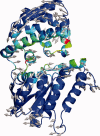Wordom: a user-friendly program for the analysis of molecular structures, trajectories, and free energy surfaces
- PMID: 21387345
- PMCID: PMC3151548
- DOI: 10.1002/jcc.21688
Wordom: a user-friendly program for the analysis of molecular structures, trajectories, and free energy surfaces
Abstract
Wordom is a versatile, user-friendly, and efficient program for manipulation and analysis of molecular structures and dynamics. The following new analysis modules have been added since the publication of the original Wordom paper in 2007: assignment of secondary structure, calculation of solvent accessible surfaces, elastic network model, motion cross correlations, protein structure network, shortest intra-molecular and inter-molecular communication paths, kinetic grouping analysis, and calculation of mincut-based free energy profiles. In addition, an interface with the Python scripting language has been built and the overall performance and user accessibility enhanced. The source code of Wordom (in the C programming language) as well as documentation for usage and further development are available as an open source package under the GNU General Purpose License from http://wordom.sf.net.
Copyright © 2010 Wiley Periodicals, Inc.
Figures






Similar articles
-
Wordom update 2: A user-friendly program for the analysis of molecular structures and conformational ensembles.Comput Struct Biotechnol J. 2023 Jan 27;21:1390-1402. doi: 10.1016/j.csbj.2023.01.026. eCollection 2023. Comput Struct Biotechnol J. 2023. PMID: 36817953 Free PMC article.
-
Wordom: a program for efficient analysis of molecular dynamics simulations.Bioinformatics. 2007 Oct 1;23(19):2625-7. doi: 10.1093/bioinformatics/btm378. Epub 2007 Aug 23. Bioinformatics. 2007. PMID: 17717034
-
PYCHEM: a multivariate analysis package for python.Bioinformatics. 2006 Oct 15;22(20):2565-6. doi: 10.1093/bioinformatics/btl416. Epub 2006 Jul 31. Bioinformatics. 2006. PMID: 16882648
-
BALLView: an object-oriented molecular visualization and modeling framework.J Comput Aided Mol Des. 2005 Nov;19(11):791-800. doi: 10.1007/s10822-005-9027-x. Epub 2006 Feb 10. J Comput Aided Mol Des. 2005. PMID: 16470421
-
Biskit--a software platform for structural bioinformatics.Bioinformatics. 2007 Mar 15;23(6):769-70. doi: 10.1093/bioinformatics/btl655. Epub 2007 Jan 18. Bioinformatics. 2007. PMID: 17237072
Cited by
-
Key interaction networks: Identifying evolutionarily conserved non-covalent interaction networks across protein families.Protein Sci. 2024 Mar;33(3):e4911. doi: 10.1002/pro.4911. Protein Sci. 2024. PMID: 38358258 Free PMC article.
-
Intrinsic Dynamics of the ClpXP Proteolytic Machine Using Elastic Network Models.ACS Omega. 2023 Feb 14;8(8):7302-7318. doi: 10.1021/acsomega.2c04347. eCollection 2023 Feb 28. ACS Omega. 2023. PMID: 36873006 Free PMC article.
-
Disordered binding of small molecules to Aβ(12-28).J Biol Chem. 2011 Dec 2;286(48):41578-41588. doi: 10.1074/jbc.M111.285957. Epub 2011 Oct 3. J Biol Chem. 2011. PMID: 21969380 Free PMC article.
-
Modeling ligand recognition at the P2Y12 receptor in light of X-ray structural information.J Comput Aided Mol Des. 2015 Aug;29(8):737-56. doi: 10.1007/s10822-015-9858-z. Epub 2015 Jul 21. J Comput Aided Mol Des. 2015. PMID: 26194851 Free PMC article.
-
Characterization of the flexibility of the peripheral stalk of prokaryotic rotary A-ATPases by atomistic simulations.Proteins. 2016 Sep;84(9):1203-12. doi: 10.1002/prot.25066. Epub 2016 Jun 1. Proteins. 2016. PMID: 27177595 Free PMC article.
References
-
- Seeber M, Cecchini M, Rao F, Settanni G, Caflisch A. Bioinformatics. 2007;23:2625. - PubMed
-
- Brooks BR, Bruccoleri RE, Olafson BD, States DJ, Swaminathan S, Karplus M. J Comput Chem. 1983;4:187.
-
- Brooks BR, Brooks CL, III, Mackerell AD, Jr., Nilsson L, Petrella RJ, Roux B, Won Y, Archontis G, Bartels C, Boresch S, Caflisch A, Caves L, Cui Q, Dinner AR, Feig M, Fischer S, Gao J, Hodoscek M, Im W, Kuczera K, Lazaridis T, Ma J, Ovchinnikov V, Paci E, Pastor RW, Post CB, Pu JZ, Schaefer M, Tidor B, Venable RM, Woodcock HL, Wu X, Yang W, York DM, Karplus M. J Comput Chem. 2009;30:1545. - PMC - PubMed
-
- Lindahl E, Hess B, van der Spoel D. J Mol Model. 2001;7:306.
Publication types
MeSH terms
Substances
Grants and funding
LinkOut - more resources
Full Text Sources
Other Literature Sources

